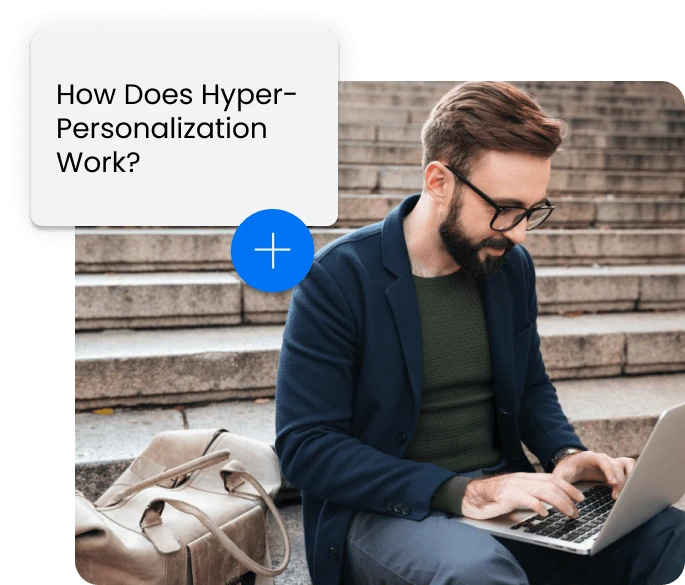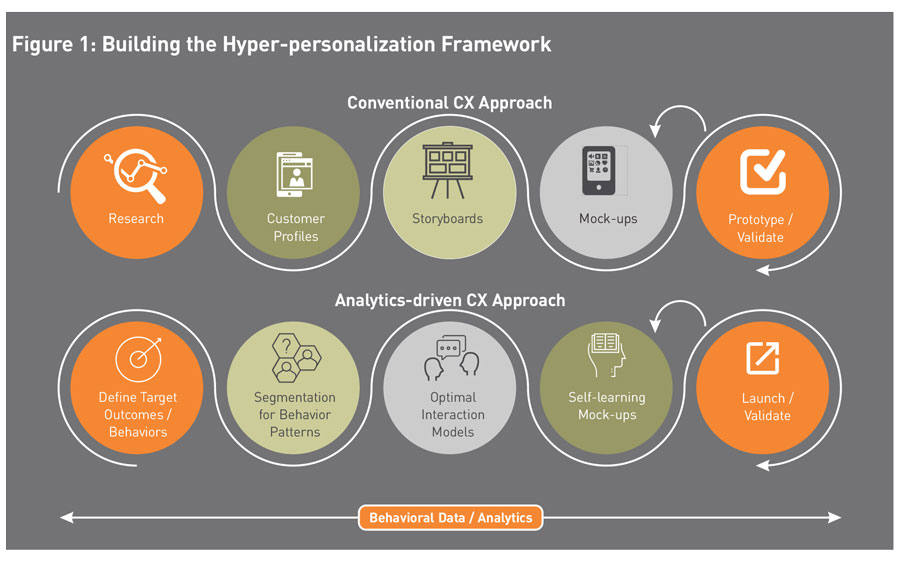Hyper-Personalization

Table of contents
What is Hyper-Personalization?
Hyper-personalization is a marketing strategy that goes beyond traditional personalization techniques by leveraging real-time data, artificial intelligence (AI), and machine learning (ML) to deliver content, product recommendations, and other information relevant to each user at any given time. By analyzing real-time data on patterns and behaviors, companies can send contextualized messages to customers at the right time, place, and via their preferred channels.
How Does Hyper-Personalization Work?
Hyper-personalization is the process of gathering real-time behavioral data from customers to help companies create and modify products and experiences accordingly. Combining a thorough understanding of both the product and your audiences, with a clear vision of how data and technology can help you leverage this information, is key in crafting a customized strategy.
Hyper-personalization aims to improve the following key metrics:
Engagement
Every customer expects at least a basic level of personalization—calling them by their first names or remembering their preferences, for example. Leveraging browsing data to create personalized recommendations might be commonplace today, but your company or brand can still stand out in terms of customer engagement.
Contact centers often add a personal touch to customer interactions. Arming contact center agents with the power of customer segmentation, browsing history, and purchasing history allows for hyper-personalized calls that deliver unique value to customers when they need it.
Relevance
A customer-focused strategy is only meaningful if the content or product you offer to customers is relevant to them. Gathering data isn’t enough; to determine what’s relevant to customers, you need to have the right data and know-how to use it.
Identifying context across channels is key in ensuring that you don’t box customers into categories that they feel they don’t really belong. Consider the customer’s goals with every interaction and compare this with trends in other segments so you can offer something relevant and timely.
Trust
In today’s data-driven economy, trust is an extremely important facet that shouldn’t be ignored. Tracking your customers’ every move can cause unease, so it’s important to be transparent about what you plan to do with customer data. According to Internet Society and Consumers International, 69% of consumers have expressed concern about how their personal data is collected, especially in mobile apps.
Trust should be integrated into the overall customer experience by showing empathy. Train employees and contact center agents to be empathetic listeners and communicators. Give customers the option to talk to a customer service representative if they wish to do so. Providing customers the “human touch” shows that you care and will help develop lasting relationships.
What is the Difference Between Personalization and Hyper-Personalization?
Traditional personalization is a simple approach that focuses on promoting familiarity and putting customers at ease. It uses transactional and personal information like first name, organizational affiliation, and previous purchases to profile customers and make intelligent predictions based on their characteristics.
It’s an ideal first step because it helps identify customer traits and commonalities, and offers services based on these. Sending emails to customers with their first name on the subject line is an example of traditional personalization. It’s personal, but it lacks engagement elements that would help capture customers’ attention and encourage interaction.
Hyper-personalization goes further by integrating real-time behavioral data into the mix, including browsing histories, in-app behavior, and personal web preferences. As such, it’s a more complex approach and requires tools like data-processing systems and digital adoption platforms.
Real-time data and context provide a hyper-personalized customer experience that lets you offer laser-targeted products, promotions, and content.
For example, a brief interaction with a mobile app, like a customer browsing for pink shirts, provides specific information about that customer, including a preference for the color pink, what time and day the interaction occurred, and the price range within which the customer browsed. This could then help companies send more relevant emails or push notifications to said customer at a convenient time and through a preferred channel.
Hyper-Personalization Model
The ultimate goal of hyper-personalization is to drive customer engagement and increase conversion rates through an enhanced customer experience. The main challenge of implementation, ironically, is technology. Many companies aren’t properly equipped to handle the data management requirements and find it hard to build sustainable data architecture.
Organizational structure is also a consideration; teams working in silos make it difficult to hold any group or individual accountable for hyper-personalization goals. To efficiently build and implement a hyper-personalized model, it’s important to move away from the traditional CX approach and adopt a more data-driven strategy.
Below is a comparison of both approaches:

Hyper-Personalization Examples
Hyper-personalization demands innovative tactics and modern platforms to meet customer and organizational requirements. Companies need to collect, analyze, and transform data into actionable insights that will support overall business goals.
A number of legacy systems can be modernized to support this, but they fail to provide the capability to work with both digital and voice channels. This often leads to proprietary solutions that require patching together applications, which makes maintenance more challenging and less ideal.
Still, there are several organizations that have embraced the hyper-personalized approach with the help of digital adoption platforms and composability. Below are a few examples.
Hyper-Personalization in Banking
Capital One is a US bank that went all-in with hyper-personalization, leveraging conversational AI to create the bank’s intelligent assistant Eno. Through this innovative chatbot, Capital One is able to send personalized notifications, offers, and assist with managing personal finances and other simple tasks.
What makes their approach innovative is that they partnered with retailers to provide geo-specific prompts, featuring offers when a customer is close or within the location of these partners.
Hyper-Personalization in Retail
Amazon is a retail giant that never lags behind when it comes to innovation. It has been taking the hyper-personalization approach for years, with access to data that includes customers’ full names, category browsing habits, purchase history, average spend amount, and brand affinity—to name a few.
With this data, Amazon creates contextual email and push messages that highlight features and deals relevant to specific customers. The recommendation algorithm Amazon uses is referred to as “item-to-item collaborative filtering,” which recommends products based on the following:
- Customers’ purchase history
- Items in a customer’s shopping cart
- Items a customer has liked or rated
- Items liked and purchased by other customers
Hyper-Personalization in Healthcare
Avia Healthcare collects and analyzes customer data to create hyper-personalized experiences or develop an “n-of-1” view of each patient. This view looks at each patient individually to determine definitively if a specific treatment works for a particular individual.
This is in contrast to looking at patients as part of a segment or demographic. Through analyzing patient data, Avia Healthcare is able to provide its customers with marketing communications that are tailored to their specific needs.
The company’s approach can be broken down into four tiers:
- Tier 1: Basic preferences and needs
- Tier 2: Proactive communication
- Tier 3: Personalized navigation
- Tier 4: Tailored care delivery
Hyper-Personalization in Marketing
Starbucks is known for its marketing prowess, and it isn’t one to hold back when it comes to hyper-personalization. With its mobile app, the brand is able to offer unique experiences to each customer based on their preferences, previous app activity, and recent purchases.
Starbucks uses an AI-based algorithm to push personalized food and beverage suggestions and has over 400,000 variants of hyper-personalized messages promoting compelling offers relevant to each customer.